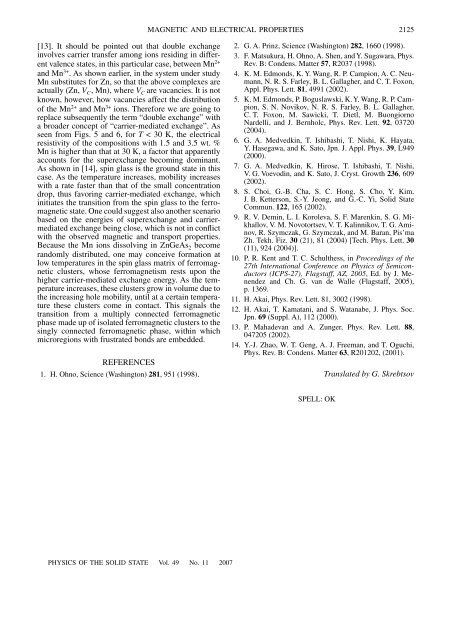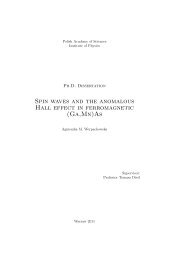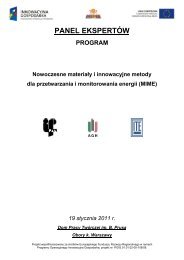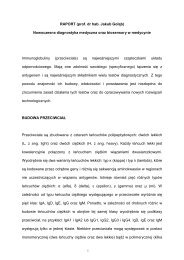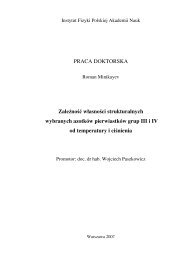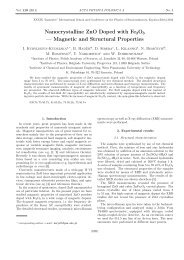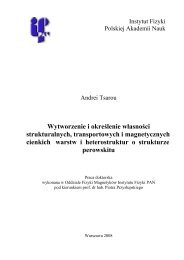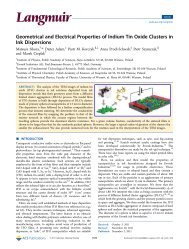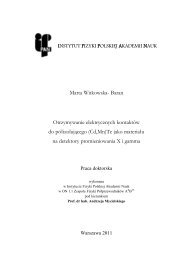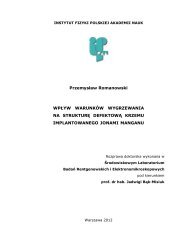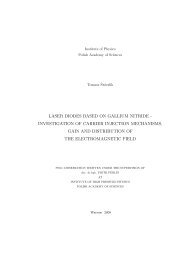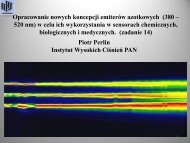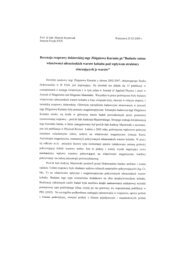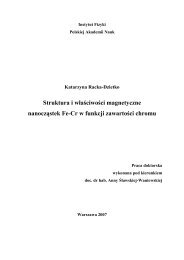Magnetic and Electrical Properties of the ZnGeAs2 : Mn Chalcopyrite
Magnetic and Electrical Properties of the ZnGeAs2 : Mn Chalcopyrite
Magnetic and Electrical Properties of the ZnGeAs2 : Mn Chalcopyrite
Create successful ePaper yourself
Turn your PDF publications into a flip-book with our unique Google optimized e-Paper software.
MAGNETIC AND ELECTRICAL PROPERTIES 2125[13]. It should be pointed out that double exchangeinvolves carrier transfer among ions residing in differentvalence states, in this particular case, between <strong>Mn</strong> 2+<strong>and</strong> <strong>Mn</strong> 3+ . As shown earlier, in <strong>the</strong> system under study<strong>Mn</strong> substitutes for Zn, so that <strong>the</strong> above complexes areactually (Zn, V C , <strong>Mn</strong>), where V C are vacancies. It is notknown, however, how vacancies affect <strong>the</strong> distribution<strong>of</strong> <strong>the</strong> <strong>Mn</strong> 2+ <strong>and</strong> <strong>Mn</strong> 3+ ions. Therefore we are going toreplace subsequently <strong>the</strong> term “double exchange” witha broader concept <strong>of</strong> “carrier-mediated exchange”. Asseen from Figs. 5 <strong>and</strong> 6, for T < 30 K, <strong>the</strong> electricalresistivity <strong>of</strong> <strong>the</strong> compositions with 1.5 <strong>and</strong> 3.5 wt. %<strong>Mn</strong> is higher than that at 30 K, a factor that apparentlyaccounts for <strong>the</strong> superexchange becoming dominant.As shown in [14], spin glass is <strong>the</strong> ground state in thiscase. As <strong>the</strong> temperature increases, mobility increaseswith a rate faster than that <strong>of</strong> <strong>the</strong> small concentrationdrop, thus favoring carrier-mediated exchange, whichinitiates <strong>the</strong> transition from <strong>the</strong> spin glass to <strong>the</strong> ferromagneticstate. One could suggest also ano<strong>the</strong>r scenariobased on <strong>the</strong> energies <strong>of</strong> superexchange <strong>and</strong> carriermediatedexchange being close, which is not in conflictwith <strong>the</strong> observed magnetic <strong>and</strong> transport properties.Because <strong>the</strong> <strong>Mn</strong> ions dissolving in ZnGeAs 2 becomer<strong>and</strong>omly distributed, one may conceive formation atlow temperatures in <strong>the</strong> spin glass matrix <strong>of</strong> ferromagneticclusters, whose ferromagnetism rests upon <strong>the</strong>higher carrier-mediated exchange energy. As <strong>the</strong> temperatureincreases, <strong>the</strong>se clusters grow in volume due to<strong>the</strong> increasing hole mobility, until at a certain temperature<strong>the</strong>se clusters come in contact. This signals <strong>the</strong>transition from a multiply connected ferromagneticphase made up <strong>of</strong> isolated ferromagnetic clusters to <strong>the</strong>singly connected ferromagnetic phase, within whichmicroregions with frustrated bonds are embedded.REFERENCES1. H. Ohno, Science (Washington) 281, 951 (1998).2. G. A. Prinz, Science (Washington) 282, 1660 (1998).3. F. Matsukura, H. Ohno, A. Shen, <strong>and</strong> Y. Sugawara, Phys.Rev. B: Condens. Matter 57, R2037 (1998).4. K. M. Edmonds, K. Y. Wang, R. P. Campion, A. C. Neumann,N. R. S. Farley, B. L. Gallagher, <strong>and</strong> C. T. Foxon,Appl. Phys. Lett. 81, 4991 (2002).5. K. M. Edmonds, P. Boguslawski, K. Y. Wang, R. P. Campion,S. N. Novikov, N. R. S. Farley, B. L. Gallagher,C. T. Foxon, M. Sawicki, T. Dietl, M. BuongiornoNardelli, <strong>and</strong> J. Bernholc, Phys. Rev. Lett. 92, 03720(2004).6. G. A. Medvedkin, T. Ishibashi, T. Nishi, K. Hayata,Y. Hasegawa, <strong>and</strong> K. Sato, Jpn. J. Appl. Phys. 39, L949(2000).7. G. A. Medvedkin, K. Hirose, T. Ishibashi, T. Nishi,V. G. Voevodin, <strong>and</strong> K. Sato, J. Cryst. Growth 236, 609(2002).8. S. Choi, G.-B. Cha, S. C. Hong, S. Cho, Y. Kim,J. B. Ketterson, S.-Y. Jeong, <strong>and</strong> G.-C. Yi, Solid StateCommun. 122, 165 (2002).9. R. V. Demin, L. I. Koroleva, S. F. Marenkin, S. G. Mikhaœlov,V. M. Novotortsev, V. T. Kalinnikov, T. G. Aminov,R. Szymczak, G. Szymczak, <strong>and</strong> M. Baran, Pis’maZh. Tekh. Fiz. 30 (21), 81 (2004) [Tech. Phys. Lett. 30(11), 924 (2004)].10. P. R. Kent <strong>and</strong> T. C. Schul<strong>the</strong>ss, in Proceedings <strong>of</strong> <strong>the</strong>27th International Conference on Physics <strong>of</strong> Semiconductors(ICPS-27), Flagstaff, AZ, 2005, Ed. by J. Menendez<strong>and</strong> Ch. G. van de Walle (Flagstaff, 2005),p. 1369.11. H. Akai, Phys. Rev. Lett. 81, 3002 (1998).12. H. Akai, T. Kamatani, <strong>and</strong> S. Watanabe, J. Phys. Soc.Jpn. 69 (Suppl. A), 112 (2000).13. P. Mahadevan <strong>and</strong> A. Zunger, Phys. Rev. Lett. 88,047205 (2002).14. Y.-J. Zhao, W. T. Geng, A. J. Freeman, <strong>and</strong> T. Oguchi,Phys. Rev. B: Condens. Matter 63, R201202, (2001).Translated by G. SkrebtsovSPELL: OKPHYSICS OF THE SOLID STATE Vol. 49 No. 11 2007


